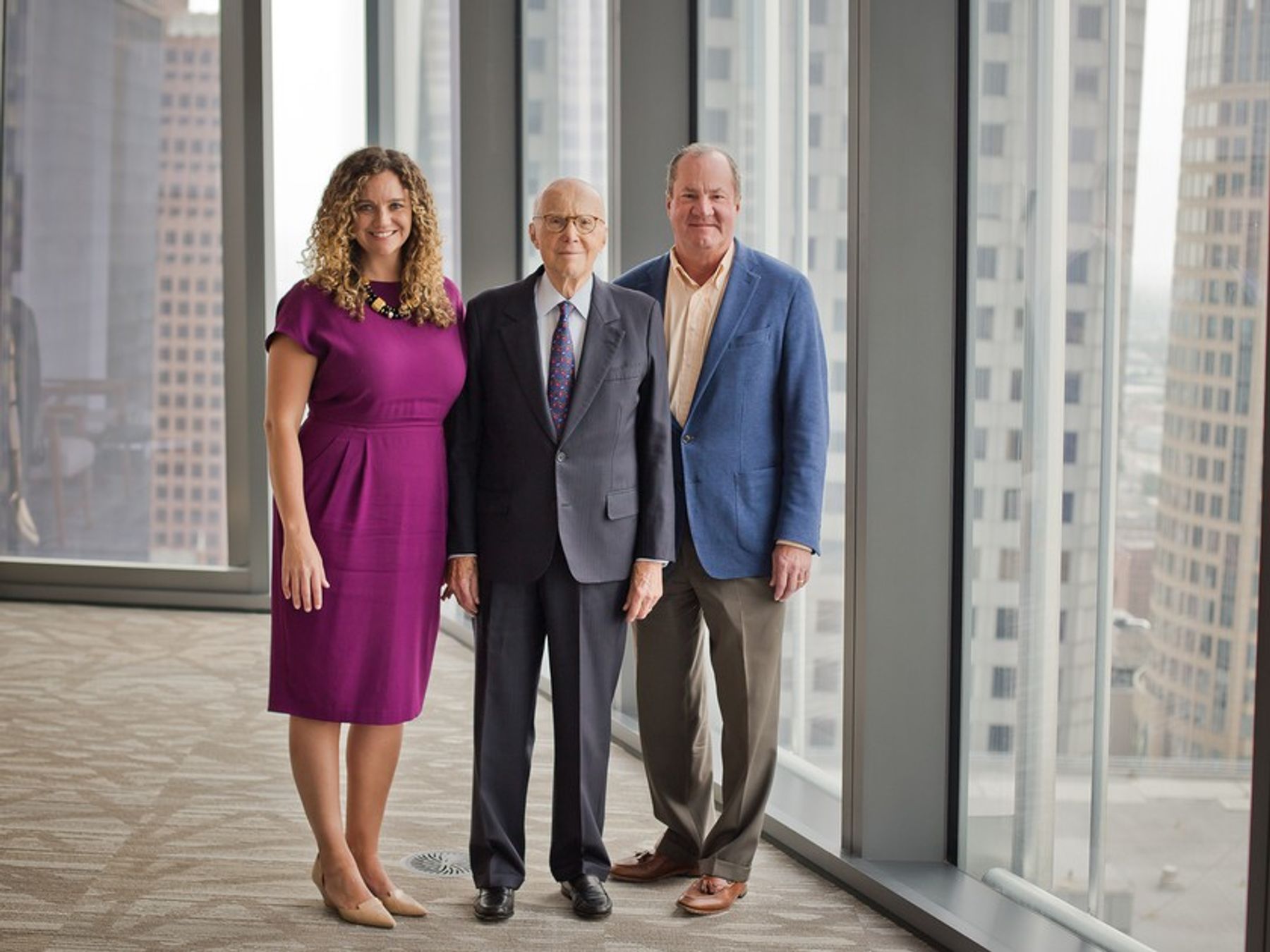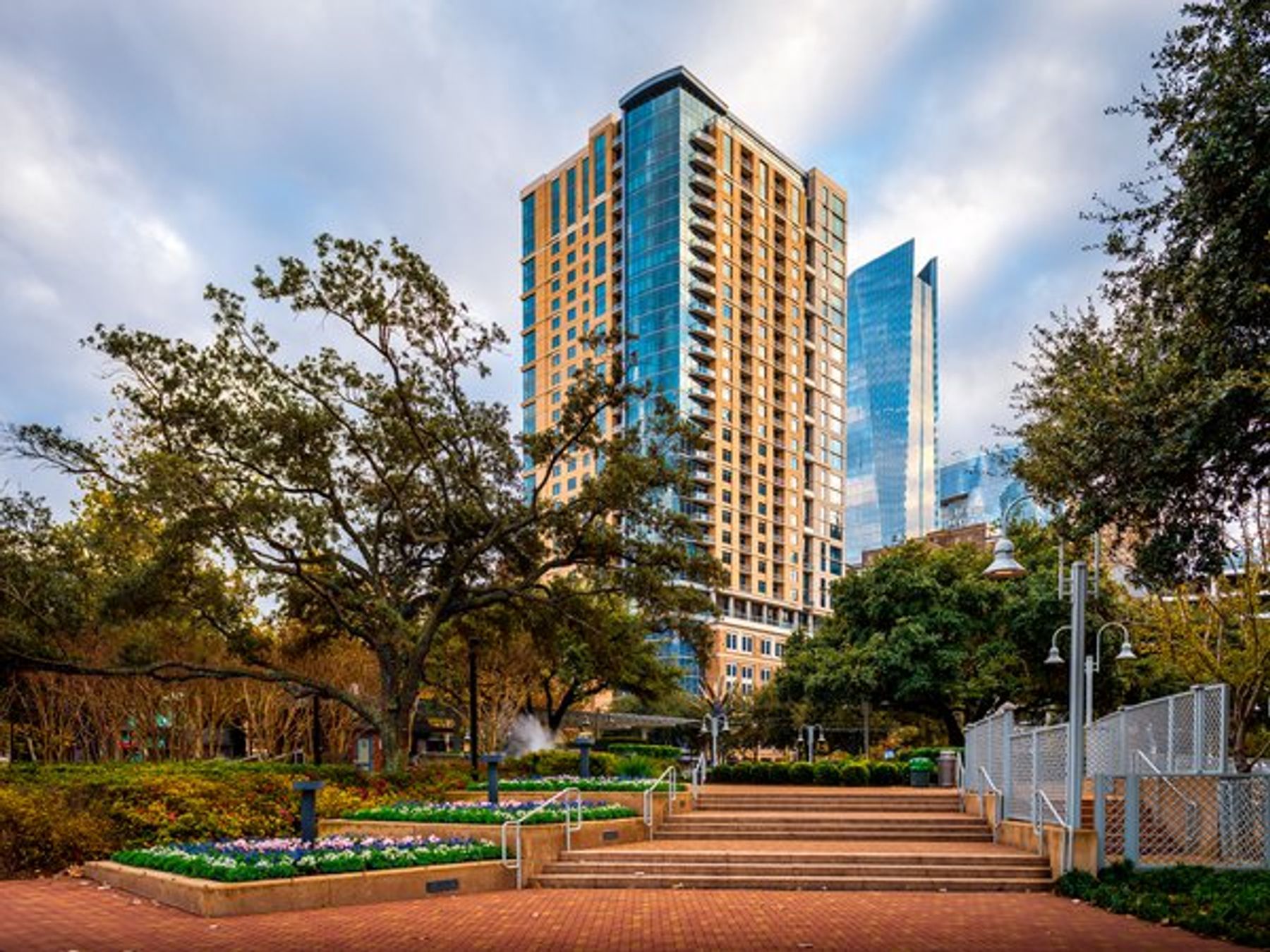Architecture • Business • Development • Profiles
Above and Beyond:
Hines’ more than 60 years of influence on Houston and commercial real estate worldwide
Whether you’re an architecture nut or a casual admirer of Houston’s marquee buildings, such as Pennzoil Place, One Shell Plaza and Williams Tower, you have the Houston heat to thank for such handsome structures – the heat and Gerald Hines.
Hines grew up in Indiana and following graduation from Purdue University with a degree in mechanical engineering, he took a job with a Detroit-based engineering company that specialized in air conditioning. After training and orientation, he was given the choice of three office locations – Indianapolis, Detroit and Houston.
He chose Houston, in part because a couple of college friends lived here, but also because, without a doubt, the air conditioning business was going to be stronger in Houston than the other cities.
While still working for the air conditioning company, Hines took on his first project – a 5,000-square-foot warehouse. He met his first client at a neighbor’s barbecue, and when the fellow mentioned he needed a warehouse for his company, Gerald Hines said immediately, “I can build that for you.” And he did, eventually founding his own firm, Gerald D. Hines Interests in 1957.
That’s right: Hines ’57.
So, what’s the secret to success?
“I wanted to build a little differently than other people had done,” says Hines, who turns 94 this year and remains chairman of the firm he founded. “Houston was a city that seemed wide open, because it didn’t have as many restrictions on building as other cities, so it was an open world.”
More than 60 years later, his company, known today simply as Hines, has developed, redeveloped or acquired 1,348 properties, totaling over 444 million square feet worldwide. Including Texas Tower, now under construction, Hines has 31 projects to its credit in Downtown Houston alone.
With offices in 24 countries, Hines has grown to more than 4,200 employees, including Gerald Hines’ son, Jeffrey C. Hines, the company’s president and CEO, and his granddaughter, Laura Hines-Pierce, who is managing director, as well as Hines’ transformation officer (be sure to look up her twitter handle).
Jeff was drawn to work for Hines because it was a natural fit for his varied business interests. “In business school, I liked marketing, I liked finance, I liked accounting and process management, so I realized that Hines’ generalist approach lined up well with all those interests,” he says.
Laura appreciates the opportunity to blend her academic disciplines of art history and economics. “Real estate development requires the rigor of economic analysis and provides opportunities to interact with architecture and design and the experience of a space,” says Hines-Pierce.
When lauded for his success and his firm’s indelible imprint on Houston, Gerald Hines modestly replies, “Houston was a good place to be. Houston grew; it had legs.”
It’s clear he was out in front leading the pack. Urban planning, placemaking and how their projects fit into the local community have long been factored into Hines projects – in Houston and in cities across the globe.
“We always work to make sure our projects are something the local population is proud to have added to their community,” says Jeff Hines.
“If you have the goodwill of the community, then you’ll get more business and your projects will be more successful, because you’ve tied into the local atmosphere and interests,” says Gerald Hines.
With Houston as his wide-open canvas, Gerald Hines followed his boundless ideas, business instincts and commitment to design standards. This drive has not only resulted in a collection of stunning, elegant, enduring projects; but the success of those projects has influenced commercial real estate design and development across Houston and in major cities around the world.
“If you can differentiate a project it will drive costs higher, and getting it right is a challenge, but it also makes the property more desirable,” say Gerald.
“And it creates creative tension between architect and developer, so you have to strike balance,” says Jeff.
Laura adds, “If you get it right, it not only adds to the community but it’s proven, from our perspective, to drive value for the asset. It’s a place people want to be, so the project rides the cycle better, because people want to be there, tenants stay there.”
Firm’s First Decade
In the first 10 years of the firm, Hines launched and developed more than 97 projects, largely office/warehouse projects and office buildings, but also retail, parking and residential. Following the success of Joske’s (1963, now Dillard’s), construction began on Neiman Marcus in 1967, setting up Phase One of Houston’s retail mainstay, The Galleria, which began in 1970.
Designs on Downtown
Meanwhile, Gerald Hines had learned that Shell Oil Company was looking to move their U.S. headquarters out of New York City. He admits navigating his way through the global corporation based in the Netherlands was no easy task. Hines eventually found the right contact who became an advocate and helped illustrate the advantages of establishing not only their U.S. headquarters, but also their regional headquarters in Downtown Houston.
When Gerald Hines secured Shell in the late 1960s, it was his first high-rise office building and the firm’s first Downtown project. Beyond the magnitude of the deal for Hines and the significance of Shell relocating its U.S. headquarters from New York to Houston, One Shell Plaza was a marvel of engineering for the time. Innovations in erecting tall buildings on Houston’s dense clay made the 50-story office tower possible (previous practices only supported up to 44 stories). Its companion, the 26-story Two Shell Plaza, was completed in 1972. Both projects were designed by Skidmore, Owings & Merrill.
“Shell was obviously a very important tenant and occupier of space with a great reputation, says Gerald. “They were known as one of the premier companies of the world, so to us, to partner with them was very important to our own growth.”
“It put us on the map,” says Jeff.
“One Shell was an early example of Hines being on the leading edge of technology, building design and structural innovation,” says Laura. “That combination is now infused into Hines’ approach, it’s part of our DNA.”
Energy Capital Status
While the Houston area had been a significant hub for the oil industry since the1960s, the major companies’ offices remained in other cities. Shell’s move legitimized Houston’s claim as the energy capital, and other oil companies followed suit. And other business sectors did, too, especially banking. Numerous architecture and economy chroniclers credit One Shell Plaza for sparking a decade-long building boom Downtown.
Today, with his firm having completed more than 1,300 projects, Gerald Hines favors Pennzoil Place among Hines’ Downtown Houston accomplishments. The project was Hines’ first of 15 collaborations with then-rising star architect Philip Johnson and Johnson/Burgee Architects, the firm Johnson formed with John Burgee.
“We had two tenants on board, so we needed two towers to be able to put each of the names on the buildings – it was an outstanding opportunity to have two tenants from the beginning.”
Those tenants were Pennzoil and Zapata Oil, which had been founded by Pennzoil’s CEO Hugh Liedtke and, among others, George H.W. Bush. It was Liedtke who approached Hines about developing a distinctive building that was not a “cigar box.”
Gerald Hines had already begun collaborating with Philip Johnson for the three towers at Post Oak Central when Hines determined the Pennzoil project required a truly innovative architect to fulfill Liedtke’s request.
Pennzoil Place was completed in 1976. Johnson’s striking pair of dark bronze parallelograms conjoined by sloping atriums was proclaimed “a towering achievement” by Ada Louise Huxtable in the New York Times the same year. Pennzoil Place later won multiple awards from the American Institute of Architects (AIA), Texas Society of Architects, and the Houston Chapter of the AIA.
The departure from the flat-top, slab-front structures of the 1950s and ‘60s launched a revolution in office building design in Houston that spread across the United States. Pennzoil Place is also recognized by architectural authorities as a hallmark of Post Modernism.
The project propelled Hines to national acclaim as a visionary developer who sought to marry architectural excellence and successful commercial property development, while
Pennzoil Place earned Philip Johnson national honors, such as the AIA’s Gold Medal and later selection as its first Pritzker Prize winner in 1979.
Jeff Hines brags, “My dad wrote the successful playbook for integrating great architecture into commercial buildings.”
It’s worth noting that despite the dark cloud of an economic recession that hovered from 1973 to 1975, Hines inserted two additional floors into each tower of Pennzoil Place due to the high demand for office leases in the project. Another bonus: The optical illusion, visible from Downtown’s surrounding freeways, of seeing the two angled forms split apart and join back together continues to delight freeway travelers to this day (look for it the next time you’re a passenger on a downtown-adjacent freeway.)
It wasn’t until the late 1970s and early 1980s that office towers became celebrated architectural achievements – New York’s 1958 Seagram Building, designed by Mies van der Rohe, is the rare exception.
“Before that era, great architects primarily designed university buildings and museums,” says Gerald Hines.
Houston Skyline Icons
In a city as flat as Houston, skyscrapers make up our manmade mountain range, which began rising with One Shell Plaza, Houston’s first skyscraper. After the success of Pennzoil Place, Hines went on to conceive and build many more “peaks” in our skyline.
In the early 1980s, Hines delivered three stellar additions to Downtown’s skyline designed by renowned architects:
- 1100 Louisiana, 1980, Skidmore, Owings & Merril
- 600 Travis (formerly JPMorgan Chase Tower), 1982, I.M. Pei
- 700 Louisiana (formerly Bank of America Center), 1983, Philip Johnson/John Burgee
Meanwhile, another Hines-Philip Johnson project was completed in 1983 over on Post Oak – the iconic and award-winning Williams Tower, adjacent to The Galleria. At 64 floors, Williams Tower boasts many distinctions: it is Houston’s tallest building outside of Downtown, which makes it one of the most-visible buildings in the city.
Upon its debut, Williams Tower (originally called Transco Tower) was the world’s tallest building located outside of a central business district. That title has since been lost, but Williams Tower is always there for you, Houston, as its upper floors and crowning searchlight can be seen for miles in all directions. And it’s mesmerizing Waterwall remains one of Houston’s most photographed locations (the public park now named for Gerald D. Hines).
Projects across U.S. and worldwide
Throughout the 1980s, Hines completed significant projects across the U.S, from Spokane, Washington to Washington, D.C. By the 1990s, the firm had major buildings in Mexico City, Moscow, Berlin, Paris and Barcelona, in addition numerous projects across the U.S.
In response to the firm’s growth, Hines also established a regional structure and set up regional office in major cities in the U.S. and worldwide. In 1990, after nine years with the firm, Jeff Hines was appointed president of Hines, as Gerald Hines became chairman.
Eye Opener
“When it was dad’s turn to take me to school, he’d get me out the door by 5 or 5:30 in the morning to go visit construction sites before even the contractors were there,” says Jeff Hines. “So I learned at an early age the intensity and passion that dad had for what he does – and the attention to detail that he paid to everything. Of course, I realized this much later, upon reflection, not during those pre-dawn, before-school detours.”
Growth through Green Initiatives
In 1999, as the Environmental Protection Agency expanded its ENERGY STAR program to commercial buildings, 28 Hines buildings received the label during the first year of the program, followed by 13 more the next year.
As of 2019, Hines has been recognized by the EPA a total of 15 times as an outstanding partner with the program. Presently, Hines-managed properties are 41 percent more energy efficient than the national average.
In 2009, the firm launched Hines GREEN OFFICE (HinesGO) to improve sustainable operations within the firm’s own offices, later expanding the initiative to all of its office tenants. Today, more than 770 tenants have achieved the green designation.
Latest Additions to Houston Skyline
More recently, Hines added two sleek, LEED Platinum-certified towers designed by Pickard Chilton – BG Group Place in 2011, with its eye-catching cutaway notch; and 609 Main at Texas in 2017, distinguished by its angled crown.
Still to come is Texas Tower, designed by Pelli Clarke Pelli. The 1-million-square-foot office tower is currently under construction on the former Houston Chronicle site and slated for completion in late 2021.
Hines’ leadership is so invested in the new Downtown tower that it plans to relocate the firm’s global headquarters into 155,000 square feet at Texas Tower, vacating its space at Williams Tower, which housed Hines since the mid-80s.
“With all that we’re doing in all the dynamic central business districts around the world, it’s clear that Downtown Houston is where we need to be,” says Jeff Hines. “We figure we ought to be in the place that showcases our latest and greatest innovations and technology—and Texas Tower—is off the charts, so we’re very excited to be a part of it.”
“The tower is set on the block at 45-degree angle, which provides incredible views for the tenants. From the exterior, it’s classically great architecture,” says Jeff Hines. “It’s designed from the inside out to offer the tenant an experience made up of the latest standards – the amount of light, the right air quality, energy efficiency and flexible spaces.”
“And it’s not just about tenant spaces,” says Laura Hines-Pierce. “The whole building feels like it’s at their fingertips and seamlessly integrates within the cityscape at the ground level. If we do it well, it won’t feel like an office. It will be space people simply want to be in.”
Continuing to Change the Landscape
“Real estate is at a very interesting point in its life cycle,” says Laura. “It’s one of the last industries to be deeply impacted by demographic shifts, technology changes, etc. We’re really just at the outset of that.”
She suggests that real estate could change more rapidly in the next five to seven years than it has in the last 30 years. “This is due not only to demographic shifts and user preferences, but also due to the fact that there was a major real estate boom in the 1970s and ’80s, so there’s a lot of aging stock than can be reimagined and rethought,” says Laura. “Maintaining our leading-edge design, and adding to the cityscape is something that we’re very excited about,” says Laura.
Moving in on Residential
Think that Hines all about major office developments? Think again. The firm has widened its focus on residential projects significantly over the past decade. Currently, Hines has more square feet in residential projects in design and underway than office projects — 19+ million square feet, versus 17+ million square feet respectively.
Hines global residential stats
- More than 29.4 million square feet of developments completed to date
- More than 19 million square feet of developments underway
- More than 48 million square feet combined
“We’ve made a big strategic push in residential over the past several years, which was also fueled by our decision to get into multi-family projects nine years ago,” says Jeff Hines.
“At the time that was very new and a little scary,” says Gerald Hines.
“We were less familiar back then, but our timing has been good and we’ve been able to prove that we can tap the footprint of talent we have across the globe and bring in specific product expertise to assist with each project,” says Jeff Hines.
“When you have that knowledge from all the asset classes. and the capacity across the board, then you can turn on a lever when the market is right,” say Laura Hines-Pierce.
Downtowners are familiar with Hines’ Aris Market Square, the 32-story residential tower that opened in 2018 and The Preston – a 46-story residential tower with 331 rental units is currently under construction and expected to be open in 2022.
Mentioned in this Post
Pennzoil Place
711 Louisiana St


